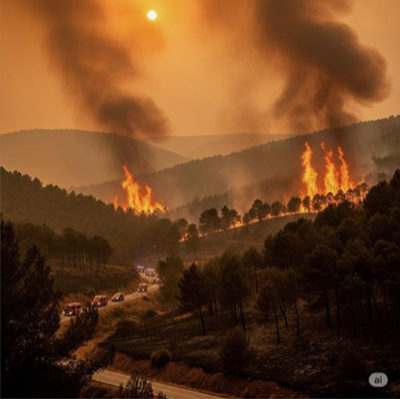

Firefighting should not just focus on putting out fires
The wave of forest fires that has ravaged Spain this summer has left a devastating toll. Tecnifuego warns that firefighting should not focus solely on putting out fires, but should begin months beforehand with work planned throughout the year.
That work includes forest clearance, the creation and maintenance of firebreaks, biomass reduction in critical areas and installation of early detection and response systems (sensors, aerial surveillance and interconnected warning networks) to enable action to be taken before the fire spreads.
The images of charred mountains and plumes of smoke visible for miles have been repeated across at least ten autonomous regions during the month of August. With multiple active outbreaks, the country has remained on high alert with mass evacuations, roads and rail lines cut, and the Military Emergency Unit (UME) deployed on the ground. This scenario is compounded by a serious environmental impact. Fires release large quantities of CO₂, fine particles and toxic gases into the atmosphere, degrading air and water quality and endangering human and animal health, while devastating ecosystems that could take decades to recover.
The Spanish Association of Fire Protection Companies (Tecnifuego) has conveyed its sincerest condolences for the fatalities and injuries, and expressed its solidarity with those affected and their relatives. It has also acknowledged the extraordinary efforts of firefighters, forest brigades, volunteers, the security forces and the UME, who have fought tirelessly against the advance of the flames.
Extreme weather conditions, with heatwaves, strong winds and dry storms, combined with the accumulation of vegetation after the spring rains, have created a scenario of maximum risk. “The fires we are seeing are becoming faster, more dangerous and less predictable. Tackling them requires anticipating, not just reacting,” warns Antonio Tortosa, Vice-President of Tecnifuego.
Comprehensive prevention
The national reference association for fire protection stresses that firefighting should not only focus on extinguishing fires, but start months in advance with planned work throughout the year: clearing of forests, creation and maintenance of firebreaks, reduction of biomass in critical areas and installation of early detection and response systems (sensors, aerial surveillance and interconnected warning networks) that allow action to be taken before fires spread.
This approach must be complemented by unified protocols, advanced training and sufficient resources to ensure the effectiveness and safety of firefighting teams, as well as a genuine culture of self-protection among citizens.
Within this vision of integral prevention, Tecnifuego proposes to act on three complementary levels: landscape planning, adaptation of buildings and citizen education. Reducing the continuity of vegetation, diversifying land use and creating natural barriers are key actions to slow the spread of fire and limit its consequences.





